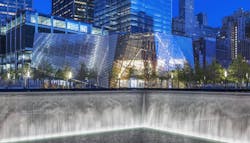National September 11 Memorial Museum Pavilion, New York
Owner: National September 11 Memorial & Museum at the World Trade Center
Architect: Snøhetta, New York
Architect: Adamson Associates International, New York
*Structural Engineer: BuroHappold Engineering, New York
General Contractor: Bovis Lend Lease, New York
Fabricator: W&W Steel, Oklahoma City, Okla. (AISC member / AISC certified fabricator and erector)
Detailer: W&W Steel, Oklahoma City, Okla. (AISC member / AISC certified fabricator and erector)
Erector: W&W Steel, Oklahoma City, Okla. (AISC member / AISC certified fabricator and erector)
*Firm that entered the project in the IDEAS2 contest
The National September 11 Memorial Museum Pavilion acts as an open and transparent entry for visitors to the below-grade museum from the memorial site. The 47,600-sq.-ft cultural facility orients the visitor within the memorial grounds and belies the complexity of the site.
Overcoming the many constraints of a site that is situated in dense urban infrastructure and that has been continually transforming since Sept. 11, 2001, required rigorous coordination and interplay among architect, engineer and other project teams working on site. Integrated structural systems, both above and below grade impacted the building’s design as well. The team had to take into consideration support for the museum below and other underground infrastructure when calculating structural loads.
The majority of the pavilion is supported over the PATH train station and tracks, while the remainder sits atop the museum. Analysis of these below-grade structures, the memorial pools, and surrounding infrastructure, in addition to the pavilion’s concrete core, identified limited supports capable of carrying the loads of the pavilion. So a full-story-tall steel truss extends from the pavilion’s core to effectively cantilever the building over the PATH station hall.
The reinforced concrete core provides lateral stability for the pavilion, however, its location above the PATH tracks and station hall complicated the transfer of lateral forces to the ground. To solve this issue, the pavilion is ringed with steel and reinforced-concrete composite drag beams that transfer the forces to the museum’s shear walls. To construct the pavilion shear walls over the tracks, erection trusses support the full weight of the four-story pavilion concrete walls.
Among the most striking features noticed upon entering to the pavilion are the two 80-ft-tall artifacts known as the “tridents”, which originally formed the iconic outer structural support of the original towers. The tridents are housed in a full-height steel and glass atrium that also extends one story below grade. The atrium steel support is a complex configuration of Hollow Structural Sections (HSS) -- HSS20×8 and 20×12 steel tubes -- clad with a uniform rectangular curtainwall system set at an angle. Due to their size, the tridents were installed in 2010, prior to the installation of the atrium steel. The tridents were then protected as the atrium and remainder of the pavilion were constructed.
Within the atrium, the pavilion’s freestanding grand stairs are over 30 feet tall, and the stair widens as it descends, bringing visitors within close proximity to the tridents. The stair has limited support points, creating the appearance of floating within the space. Careful consideration to performance and vibrational aspects of the HSS stair was required to ensure visitor comfort as the visitors descend and potentially pause along this feature.
As plans for the site evolved the structural design was recalculated and adjusted, a feat advanced by the team’s understanding of the tremendous importance of the pavilion, both as a physical presence within the memorial plaza and as the visitors’ entry to the museum.
